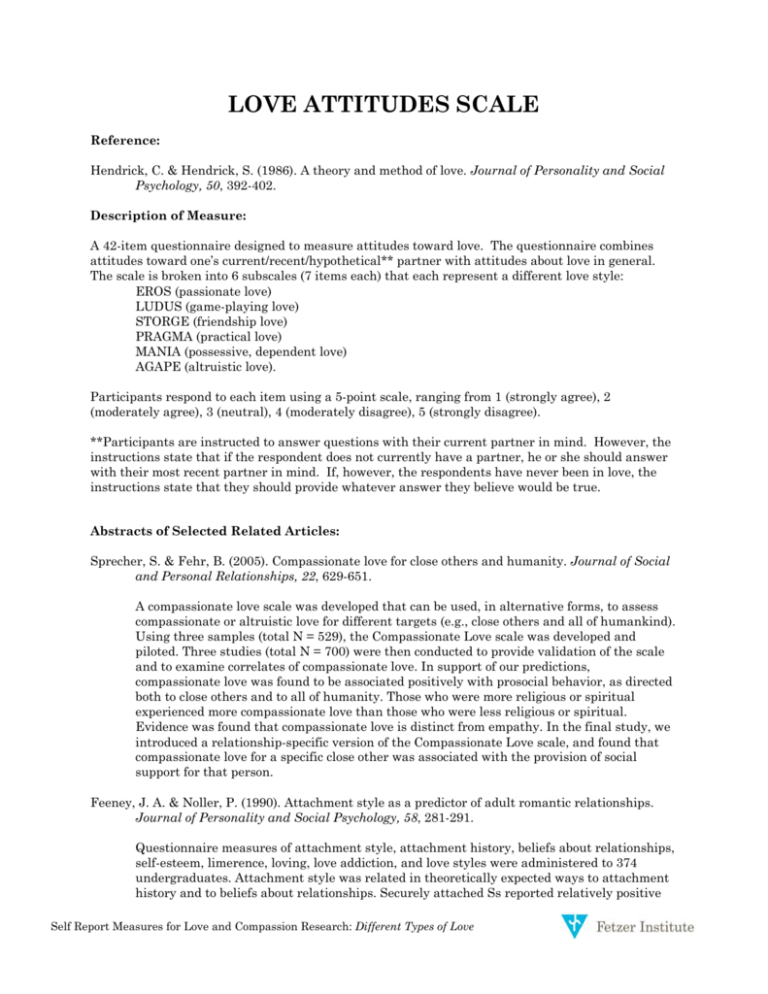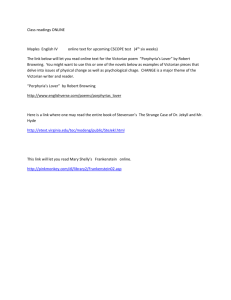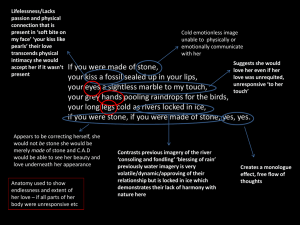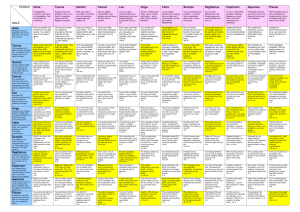LOVE ATTITUDES SCALE
advertisement

LOVE ATTITUDES SCALE Reference: Hendrick, C. & Hendrick, S. (1986). A theory and method of love. Journal of Personality and Social Psychology, 50, 392-402. Description of Measure: A 42-item questionnaire designed to measure attitudes toward love. The questionnaire combines attitudes toward one’s current/recent/hypothetical** partner with attitudes about love in general. The scale is broken into 6 subscales (7 items each) that each represent a different love style: EROS (passionate love) LUDUS (game-playing love) STORGE (friendship love) PRAGMA (practical love) MANIA (possessive, dependent love) AGAPE (altruistic love). Participants respond to each item using a 5-point scale, ranging from 1 (strongly agree), 2 (moderately agree), 3 (neutral), 4 (moderately disagree), 5 (strongly disagree). **Participants are instructed to answer questions with their current partner in mind. However, the instructions state that if the respondent does not currently have a partner, he or she should answer with their most recent partner in mind. If, however, the respondents have never been in love, the instructions state that they should provide whatever answer they believe would be true. Abstracts of Selected Related Articles: Sprecher, S. & Fehr, B. (2005). Compassionate love for close others and humanity. Journal of Social and Personal Relationships, 22, 629-651. A compassionate love scale was developed that can be used, in alternative forms, to assess compassionate or altruistic love for different targets (e.g., close others and all of humankind). Using three samples (total N = 529), the Compassionate Love scale was developed and piloted. Three studies (total N = 700) were then conducted to provide validation of the scale and to examine correlates of compassionate love. In support of our predictions, compassionate love was found to be associated positively with prosocial behavior, as directed both to close others and to all of humanity. Those who were more religious or spiritual experienced more compassionate love than those who were less religious or spiritual. Evidence was found that compassionate love is distinct from empathy. In the final study, we introduced a relationship-specific version of the Compassionate Love scale, and found that compassionate love for a specific close other was associated with the provision of social support for that person. Feeney, J. A. & Noller, P. (1990). Attachment style as a predictor of adult romantic relationships. Journal of Personality and Social Psychology, 58, 281-291. Questionnaire measures of attachment style, attachment history, beliefs about relationships, self-esteem, limerence, loving, love addiction, and love styles were administered to 374 undergraduates. Attachment style was related in theoretically expected ways to attachment history and to beliefs about relationships. Securely attached Ss reported relatively positive Self Report Measures for Love and Compassion Research: Different Types of Love perceptions of their early family relationships. Avoidant Ss were most likely to report childhood separation from their mother and to express mistrust of others. Anxiousambivalent subjects were less likely than avoidant Ss to see their father as supportive, and they reported a lack of independence and a desire for deep commitment in relationships. The self-esteem measure and each of the scales measuring forms of love were factor analyzed separately. Analyses based on scale scores derived from the resulting factors indicated that attachment style was also strongly related to self-esteem and to the various forms of love discussed in other theoretical frameworks. The results suggest that attachment theory offers a useful perspective on adult love relationships Hazan, C. & Shaver, P. (1987). Romantic love conceptualized as an attachment process. Journal of Personality and Social Psychology, 52, 511-524. This article explores the possibility that romantic love is an attachment process--a biosocial process by which affectional bonds are formed between adult lovers, just as affectional bonds are formed earlier in life between human infants and their parents. Key components of attachment theory, developed by Bowlby, Ainsworth, and others to explain the develoment of affectional bonds in infancy, were translated into terms appropriate to adult romantic love. The translation centered on the three major styles of attachment in infancy--secure, avoidant, and anxious/ambivalent--and on the notion that continuity of relationship style is due in part to mental models (Bowlby's "inner working models") of self and social life. These models, and hence a person's attachment style, are seen as determined in part by childhood relationships with parents. Two questionnaire studies indicated that (a) relative prevalence of the three attachment styles is roughly the same in adulthood as in infancy, (b) the three kinds of adults differ predictably in the way they experience romantic love, and (c) attachment style is related in theoretically meaningful ways to mental models of self and social relationships and to relationship experiences with parents. Scale Instructions: Some of the items refer to a specific love relationship, while others refer to general attitudes and beliefs about love. Whenever possible, answer the questions with your current partner in mind. If you are not currently dating anyone, answer the questions with your most recent partner in mind. If you have never been in love, answer in terms of what you think your responses would most likely be. Self Report Measures for Love and Compassion Research: Different Types of Love Please answer using the following scale: 1 = strongly agree 2 = moderately agree 3 = neutral 4 = moderately disagree 5 = strongly disagree 1. My lover and I were attracted to each other immediately after we first met. 1 2 3 4 5 2. My lover and I have the right physical "chemistry" between us. 1 2 3 4 5 3. Our lovemaking is very intense and satisfying. 1 2 3 4 5 4. I feel that my lover and I were meant for each other. 1 2 3 4 5 5. My lover and I became emotionally involved rather quickly. 1 2 3 4 5 6. My lover and I really understand each other. 1 2 3 4 5 7. My lover fits my ideal standards of physical beauty/handsomeness. 1 2 3 4 5 8. I try to keep my lover a little uncertain about my commitment to him/her. 1 2 3 4 5 9. I believe that what my lover doesn't know about me won't hurt him/her. 1 2 3 4 5 10. I have sometimes had to keep two of my lovers from finding out about each other. 1 2 3 4 5 11. I can get over love affairs pretty easily and quickly. 1 2 3 4 5 12. My lover would get upset if he/she knew of some of the things I've done with other people. Self Report Measures for Love and Compassion Research: Different Types of Love 1 2 3 4 5 13. When my lover gets too dependent on me, I want to back off a little. 1 2 3 4 5 14. I enjoy playing the "game of love" with a number of different partners. 1 2 3 4 5 15. It is hard to say exactly where friendship ends and love begins. 1 2 3 4 5 16. Genuine love first requires caring for awhile. 1 2 3 4 5 17. I expect to always be friends with the one I love. 1 2 3 4 5 18. The best kind of love grows out of a long friendship. 1 2 3 4 5 19. Our friendship merged gradually into love over time. 1 2 3 4 5 20. Love is really a deep friendship, not a mysterious, mystical emotion. 1 2 3 4 5 21. My most satisfying love relationships have developed from good friendships. 1 2 3 4 5 22. I consider what a person is going to become in life before I commit myself to him/her. 1 2 3 4 5 23. I try to plan my life carefully before choosing a lover. 1 2 3 4 5 24. It is best to love someone with a similar background. 1 2 3 4 5 25. A main consideration in choosing a lover is how he/she reflects on my family. 1 2 3 4 5 Self Report Measures for Love and Compassion Research: Different Types of Love 26. An important factor in choosing a partner is whether or not he/she will be a good parent. 1 2 3 4 5 27. One consideration in choosing a partner is how he/she will reflect on my career. 1 2 3 4 5 28. Before getting very involved with anyone, I try to figure out how compatible his/her hereditary background is with mine in case we ever have children. 1 2 3 4 5 29. When things aren't right with my lover and me, my stomach gets upset. 1 2 3 4 5 30. When my love affairs break up, I get so depressed that I have even thought of suicide. 1 2 3 4 5 31. Sometimes I get so excited about being in love that I can't sleep. 1 2 3 4 5 32. When my lover doesn't pay attention to me, I feel sick all over. 1 2 3 4 5 33. When I am in love, I have trouble concentrating on anything else. 1 2 3 4 5 34. I cannot relax if I suspect that my lover is with someone else. 1 2 3 4 5 35. If my lover ignores me for a while, I sometimes do stupid things to get his/ her attention back. 1 2 3 4 5 36. I try to always help my lover through difficult times. 1 2 3 4 5 37. I would rather suffer myself than let my lover suffer. 1 2 3 4 5 38. I cannot be happy unless I place my lover's happiness before my own. 1 2 3 4 5 Self Report Measures for Love and Compassion Research: Different Types of Love 39. I am usually willing to sacrifice my own wishes to let my lover achieve his/hers. 1 2 3 4 5 40. Whatever I own is my lover's to use as he/ she chooses. 1 2 3 4 5 41. When my lover gets angry with me, I still love him/her fully and unconditionally. 1 2 3 4 5 42. I would endure all things for the sake of my lover. 1 2 3 4 5 Scoring Each subscale is measured separately (each participant gets a different score on each subscale). The items are divided into subscales in the following way: Eros: 1-7 Ludus: 8-14 Storge: 15-21 Pragma: 22-28 Mania: 29-35 Agape: 36-42 Scoring is kept continuous. Self Report Measures for Love and Compassion Research: Different Types of Love







